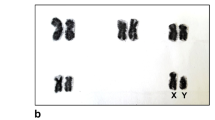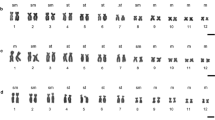Abstract
Initial analysis of Pseudohynobius flavomaculatus chromosomes determined the chromosome number of this species to be 2n = 52. A re-examination of Ranodon shihi chromosomes detected 2n = 66 chromosomes, in contrast with a previous finding of 2n = 64. The C-banding patterns of these two species and that ofBatrachuperus pinchonii were compared with each other. Regions of homoeology in the C-banding pattern among these three species represented 33.51–48.30% of the total length of their chromosomes. We also detected two types of chromosome rearrangement in hynobiid species based on the results of the present and previous cytogenetic studies.
Similar content being viewed by others
References
Fei L, Ye C, Huang Y (1990) Caudata. In: Key to Chinese Amphibia. Chongqing: Scientific Technological Press, pp 32–65 (in Chinese).
Ikebe C (1993) Cytogenetic studies on five genera in Hynobiidae Cytogenetic study of Chinese Hynobiidae 271 (Urodela) from Japan, Korea and China, with comments on phylogenetic relationships. Thesis for the degree of Doctor of Science, Chiba University, Japan, pp. 34–36.
Ikebe C, Kuro-o M, Yamamoto T, Kohno S (1990) Cytogenetic studies of Hynobiidae (Urodela) XI. Banding karyotype of Salamandrella keyserlingii Dybowski and a comparison with those of Hynobius species. Cytogenet Cell Genet 54: 169–171.
Ikebe C, Gu H, Ruan R, Kohno S (1998) Chromosomes of Hynobius chinensis GuÈnther and Hynobius amjiensis Gu from China, and comparison with those of 19 other Hynobius species. Zool Sci 15: 981–987.
Kohno S, Kuro-o M, Ikebe C et al. (1987) Banding karyotype of Korean salamander: Hynobius leechii Boulenger. Zool Sci 4: 81–86.
Kuro-o M, Ikebe C, Kohno S (1987) Cytogenetic studies of Hynobiidae (Urodela) VI. R-banding patterns in five pond-type Hynobius from Korea and Japan. Cytogenet Cell Genet 44: 69–75.
Kuro-o M, Ikebe C, Tamamoto H, Wu G, Zeng X, Kohno S (1998) Cytogenetic studies of Hynobiidae (Urodela). XIV. Analysis of the chromosome of a Chinese salamander, Batrachuperus pinchonii (David). Cell Mol Life Sci 54: 152–157.
Levan A, Fredga K, Sandberg A (1964) Nomenclature for centromeric position on chromosomes. Hereditas 52: 201–220.
Morescalchi A, Odierna G, Olmo E (1979) Karyology of the primitive salamanders, family Hynobiidae. Experientia 35: 1434–1436.
Shi LM, Ye YY, Duan XS (1980) Comparative cytogenetic studies on the red muntjac, Chinese muntjac and their F1 hybrids. Cytogenet Cell Genet 26: 22–27.
Sumner AT (1972) A simple technique for demonstrating centromere heterochromatin. Exp Cell Res 75: 304–306.
Wang X, Fang J, Tang X (1983) Preliminary observations on karyotype of Salamandrella keyserlingii. Acta Herpetol Sinica 2: 19–22 (in Chinese with English abstract).
Yang Y (1990) Karyotypic studies on nine species of Chinese salamanders. In: Zhao E, ed. From Water onto Land. Chengdu: Chinese Society for the Study of Amphibians and Reptiles, pp 150–158 (in Chinese).
Yang Y, Zhao E (1988) Meiotic chromosomes and chromosome sets in male Batrachuperus pinchonii and B. tibetanus. In: Zhao E, Hu Q, Jiang Y, Yang Y, eds. Studies on Chinese Salamanders. Ohio: Society for the Study of Amphibians and Reptiles, pp 45–48.
Yang Y, Hu Q, Zhao E (1986) Studies on the karyotype of Xenobius melanonychus and its phylogenetic significance. Acta Herpetol Sinica 5: 94–97 (in Chinese with English abstract).
Zhao E, Adler K (1993) Caudata. In: Herpetology of China. Ohio: Society for the Study of Amphibians and Reptiles, pp 105–114.
Author information
Authors and Affiliations
Rights and permissions
About this article
Cite this article
Ikebe, C., Kuro-o, M., Wu, G. et al. Cytogenetic Studies of Hynobiidae (Urodela) XVI. Comparative C- Banded Karyotype Analysis of Pseudohynobius Flavomaculatus (Fei et Ye), Ranodon Shihi (Liu) and Batrachuperus Pinchonii (David). Chromosome Res 8, 265–272 (2000). https://doi.org/10.1023/A:1009221517887
Issue Date:
DOI: https://doi.org/10.1023/A:1009221517887




